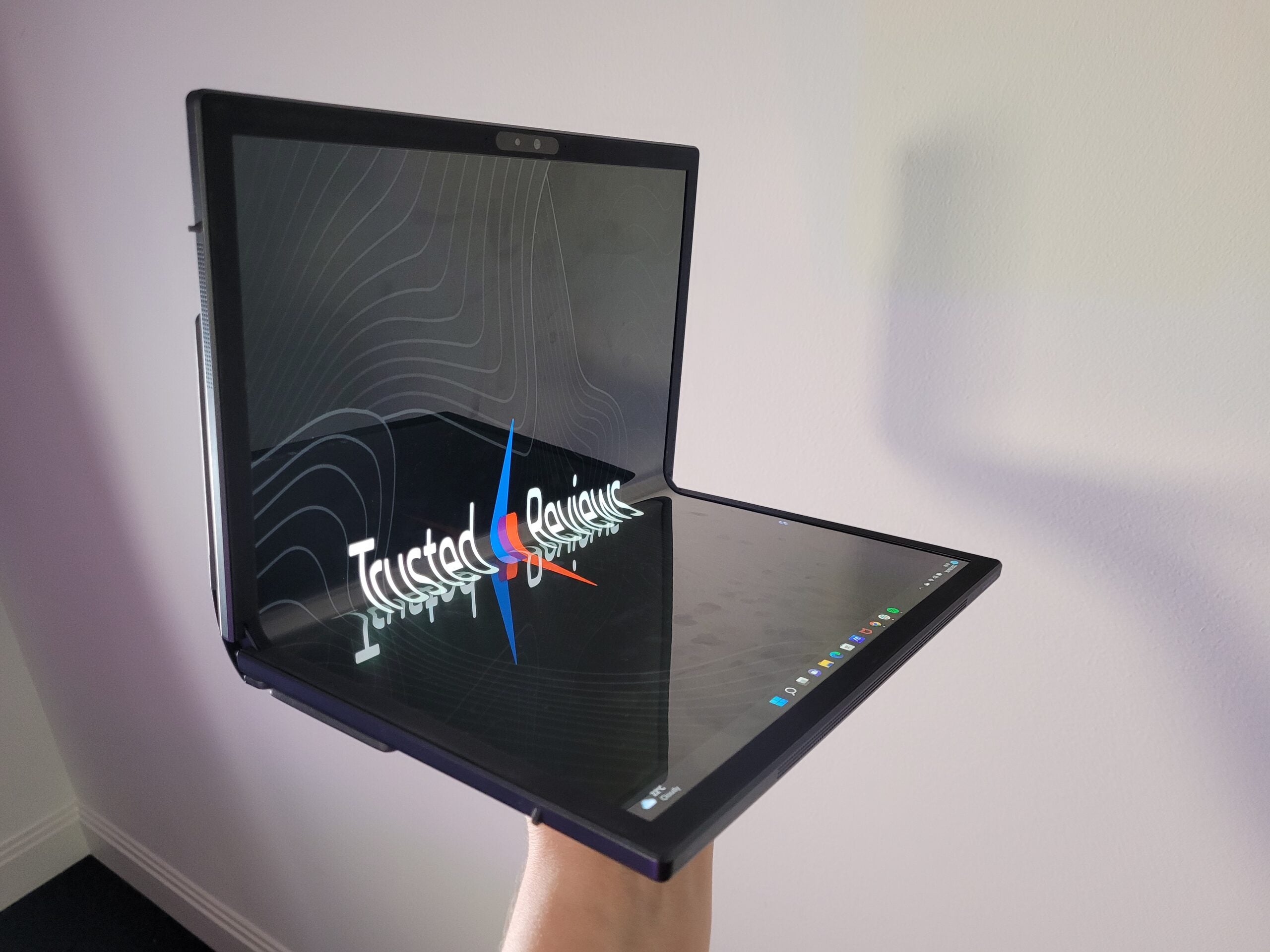The Asus Zenbook 17 Fold OLED is an extraordinary foldable device, offering the advantages of both a clamshell laptop and giant 17-inch tablet. But with plenty of rough edges, including a lacklustre battery life, it’s difficult to justify spending so much money unless you’re a wealthy tech enthusiast.
Pros
- Foldable screen offers great versatility
- OLED screen looks fantastic
- Bundled Bluetooth keyboard
- Brilliant speakers and webcam
Cons
- Absurdly high price
- Poor battery life
- Screen is prone to scratches
Availability
- UKRRP: £3299.99
- USARRP: $3999
- EuropeRRP: €3999
-
Foldable design:The main appeal of the ZenBook 17 Fold is that it can be used as either a laptop or tablet thanks to its foldable form. -
OLED screen:The OLED technology provides fantastic contrast and colour accuracy for video -
Bundled Bluetooth keyboard:Asus provides a Bluetooth keyboard with the laptop, which magnetically clips to the screen.
Introduction
Foldable phones are the new hot topic of the tech world, allowing you to bend the screen to make your phone more pocketable. Not wanting to miss out on this new foldable fad, Asus has launched a new foldable laptop.
When folded flat, it resembles a huge 17-inch tablet. But bend the screen up at 90-degree angle, and it will resemble a more conventional clamshell laptop. Asus even bundles a Bluetooth keyboard that sits atop the bottom screen, so a passer-by would easily assume this is just an ordinary laptop.
With such versatility, this is one of my favourite takes on the 2-in-1 laptop design yet, proving more functional than a 360-degree hinge, and at a greater scale than tablets with a detachable keyboard like the Surface Pro.
As impressive as the foldable technology is, this laptop isn’t without its faults. Asus warns that the plastic screen is susceptible to scratches, while the cost to make such a laptop is astronomically high – so much so that it’s difficult to recommend to anyone who isn’t a technology enthusiast flush with cash.
But even those who can’t afford the Asus Zenbook 17 Fold OLED should take interest in this foldable laptop, as if the price comes down in the future, I can see this form factor eventually becoming a popular option.
Design
- Foldable design allows for oddles of versatility
- Screen has crease marks and is prone to scratches
- Bundled Bluetooth keyboard is fine for typing
When folded flat, the Asus Zenbook 17 Fold OLED looks like a massive 17-inch tablet. In fact, it’s so large and heavy (at 1.5kg) that you likely won’t be able to use it like a traditional tablet for the vast majority of time.
I can still hold in two hands and watch Netflix without causing my hands or arms to ache, but it’s not an ideal experience compared to the likes of the iPad.
Fortunately, the Zenbook 17 Fold isn’t just a tablet, as its standout feature is the ability to bend into a 90-degree angle, taking the form of a clamshell laptop. This is only the second mainstream laptop (behind the Lenovo ThinkPad X1 Fold) to achieve such a feat, so it has the wow factor that can steal the gaze of an entire office.
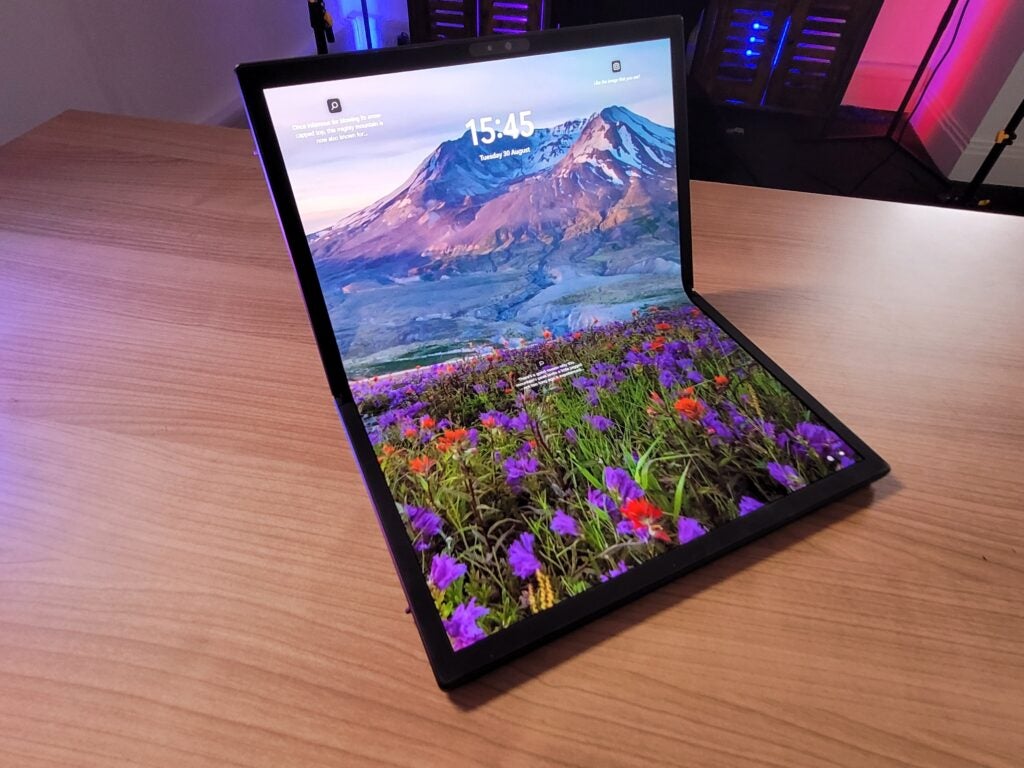
Like with any foldable, the Zenbook 17 Fold suffers from creasing. View the device at an angle, and you’ll see ugly crease marks right down the middle. Fortunately, they’re not visible when viewing the screen straight on, but could become an issue if multiple people are attempting to watch a movie.
Placing the bundled Bluetooth keyboard onto the bottom half of the screen will make the Fold look like a generic laptop – and admittedly, not a great looking one due to the chunky black bezel.
But what the Fold lacks in looks, it makes up for with functionality. The device will instantly recognise that you’ve activated laptop mode, and so will switch Windows 11 accordingly so your app or browser window is displayed in the top half of the screen. Remove the keyboard, and it will flick over to tablet mode just as quickly.
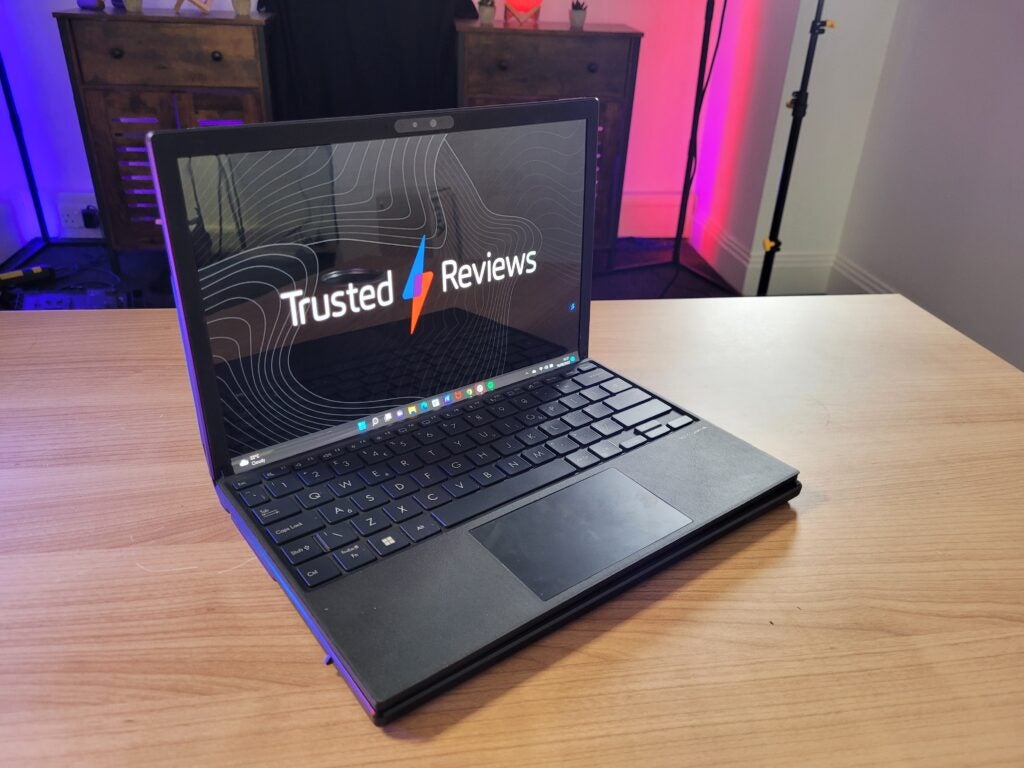
The downside of laptop mode is that you’re left with a 12.5-inch screen, which is fairly small. You generally only get budget-friendly laptops this tiny, such as Microsoft’s Surface Laptop Go 2.
I personally preferred to fold out the laptop flat, and then prop it up with its rear kickstand. This way, I was able to benefit from a huge 17-inch screen and still keep on typing with the Bluetooth keyboard. But that’s the point of the Fold, as it provides many different ways to work, and you can flip between them seamlessly.
But there are minor issues with having a Bluetooth keyboard instead of an integrated one. Firstly, the keystrokes aren’t quite as deep, lacking those firm, clicky presses that are so satisfying when typing up an essay. You also have to be mindful of the battery life, as you need to charge up both devices separately which can be a faff.
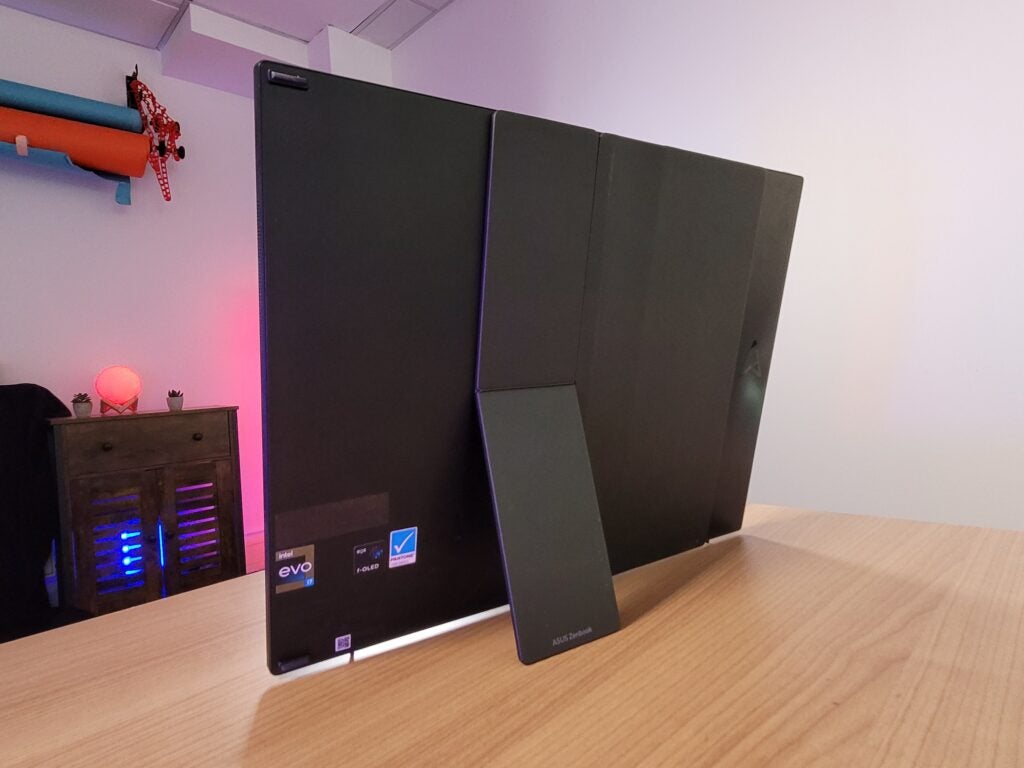
The keyboard would occasionally disconnect from the device too, especially when waking the Fold. Rebooting the keyboard would almost always solve the issue, but it’s still annoying. That said, I still found the keyboard to be perfectly usable for typing up this review. The trackpad is smooth and responsive too, so I have no complaints in that department.
There aren’t a great number of ports on the Fold 17. You get 2x USB-C (Thunderbolt 4) connections, as well as a headphone jack – that’s it. Asus at least provides a USB-C to USB-A dongle in the box, but that’s not a convenient option for those who want to use this device on the go. Compared to other laptops, especially at this price, the port selection is poor.

There’s better news on the webcam front, as Asus has included a 5MP sensor. I was pleasantly surprised by the capture quality, with bright punchy colours and sharp detail. It’s one of the best webcams on a laptop I’ve seen in ages. It’s integrated into the top bezel when the device is in clamshell laptop mode. But if you’re using it in tablet mode the sensor will instead be found on the left edge, which is a tiny bit awkward.
You’ll also find speakers on the device’s edge, which are capable of loud and detailed audio. I was perfectly happy to use the Fold’s speakers when watching movies, or even chilling out to Spotify playlists.
And once you’re finished using the device, you can fold it up like a book, even with the keyboard still in place. This makes it easier to carry around than a standard tablet, and can easily slip into a small bag.
Screen
- OLED display looks fantastic
- Hits the sweet spot for resolution
- Asus does not advise use with stylus
As its name implies, the Asus Zenbook 17 Fold OLED features a 17-inch OLED screen, and it’s a beauty. Thanks to the OLED technology, colours look vibrant and there’s perfect contrast here to ensure bright objects stand out well from dark backgrounds.
I really enjoyed propping up this device into the 17-inch tablet mode, and putting on an episode of Better Call Saul or Bob’s Burgers. It feels like I’m carrying around a mini OLED TV rather than a laptop. The 4:3 aspect ratio is a little awkward for watching movies though, as it often results in chunky black bars sandwiching the picture.
The resolution comes in at 2560 x 1920, which will be sharp enough for most people. You can of course get far better pixel density from 4K displays and the like, but I personally wouldn’t want to pay even more for this device, or impact the battery life further.

I also used a colorimter to gather data on the quality of the screen. I recorded a max brightness of 339 nits, which is perfectly fine albeit a little dimmer than some of the similarly priced competition. Asus has added in a clever feature that automatically dims the screen brightness when you’re looking away from the screen. It’s a smart way to maximise battery life, but I couldn’t find a way to deactivate it which is a little annoying.
Contrast is incredible thanks to the OLED panel, while the 99.8% sRGB and 97% DCI-P3 coverage mean it can present colours accurately enough for creative professionals.
The Fold is a touchscreen too, allowing you to use it like a tablet. It technically supports a stylus, although Asus isn’t promoting that as it’s worried the pointy nib could potentially cause scratches since the screen is so delicate.
Worried about the screen snapping in half after too many folds? Asus claims the hinge can comfortably withstand 30,000 cycles, although I haven’t had the time to test that.
Performance
- Basic CPU performance
- Not capable of graphically intense workloads
- Windows isn’t perfect for touch navigation
Despite the extravagant design and price, the Asus Zenbook 17 Fold OLED has a basic processor running the show: the Intel Core i7-1250U.
This U-Series Intel chip isn’t quite as powerful as its P-Series cousins, which means laptops such as the Dell XPS 13 Plus, LG Gram 16 (2022) and Acer Swift X all boast a speedier performance, despite being available for half the price. If speed is a priority, then the Asus Zenbook 17 Fold OLED is not for you.
| Asus Zenbook 17 Fold OLED | Dell XPS 13 Plus | LG Gram 16 (2022) | |
| CPU | Intel Core i7-1250U | Intel Core i7-1260P | Intel Core i7-1260P |
| Geekbench 5 Single / Multi | 1748 / 6524 | 1467 / 7155 | 1622 / 8234 |
| PCMark 10 | 4559 | 5211 | 5222 |
It’s perfectly fine for day-to-day use though. When browsing the web, watching Netflix and running multiple apps such as Spotify, I never noticed any slowdown. You’ll only notice performance issues when dealing with heavier workloads such as photo/video editing, especially since the Fold lacks a discrete GPU.
I have more concerns in terms of software. Windows 11 is a big upgrade on Windows 10 for touchscreen navigation, but it’s still lagging behind Android and iPadOS. Windows menus are too small for prodding and swiping, especially if you want to fiddle with the settings.
Asus has tried to improve this aspect via the ScreenXpert app, which can be opened by pressing the small icon on the side. ScreenXpert enables you to quickly adjust the landscape mode or even switch between all of the open apps. But it still doesn’t make up for Windows’ shortcomings.
The Asus Zenbook 17 Fold OLED packs a 1TB SSD, which our benchmark tests show to have read and write speeds of 6,887MB/s and 5,069MB/s respectively. Those are fantastic speeds, which should improve the performance when booting up the device or opening up an installed app.
Battery life
- Lasted 6 hrs and 30 mins in laptop form
- Struggles to hit 6 hours as a tablet
After reviewing countless laptops over the years, I’ve started to notice several red flags that generally result in poor battery life. The Asus Zenbook 17 Fold OLED has three of these red flags: an OLED screen, large display with high resolution and a slender design.
As a result, it wasn’t a great surprise to see the Fold achieve poor battery life results. When looping video on YouTube with 150-nit screen brightness, the foldable laptop was only able to last 6 hours and 30 minutes in clamshell laptop mode.
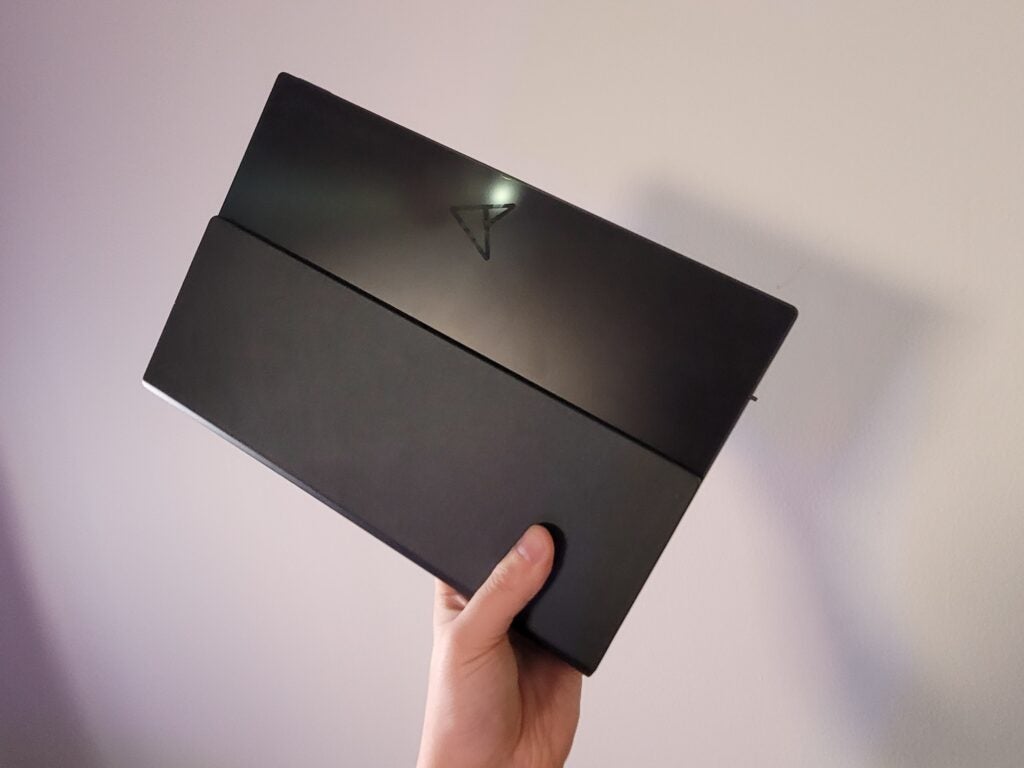
I also made sure to test the device in tablet mode, since having the full screen active will predictably see the battery life drained even quicker. My assumption turned out to be true, with the device struggling to even hit the six-hour mark.
That’s a poor result whether you compare the Fold to either rival laptops or tablets. I can understand why that’s the case, as fitting a sizable battery inside a foldable device is always going to be difficult, while the huge OLED screen will inevitably be a massive power drain.
But that doesn’t change the fact that it’s difficult justifying over $3000/£3000 on a portable PC when it won’t even be able to outlast the working day on a single charge. When using this device, I constantly found myself having to charge up either the keyboard or Fold, which can be restrictive.
Latest deals
Should you buy it?
If you want the versatility of a foldable laptop: The foldable screen makes the Asus Zenbook 17 Fold OLED one of the most versatile 2-in-1 laptops I’ve ever tested. It can be used as either a traditional clamshell laptop, or even a 17-inch OLED tablet which is handy for watching movies.
If you want value for money: The biggest issue with the Asus Zenbook 17 Fold is that it’s absurdly expensive. You won’t find good value for money here, and it is only really worthwhile if you’re a tech enthusiast who’s flush with cash.
Final Thoughts
The Asus Zenbook 17 Fold OLED is a great example of why foldable laptops can be a success. The versatile design allows for oodles of different use cases, providing the perks of both a compact ultra-portable laptop and a large 17-inch OLED tablet.
However, the astronomical price puts the Fold out of reach for the vast majority of buyers. Laptops generally only cost this much if they offer a professional or gaming-grade performance, but that’s not the case here.
Asus has been forced to up the price to offset the high production costs of the foldable screen, but the added versatility that the Fold provides fails to justify the price. You’re arguably better off opting for a MacBook Air (£1249) and 12.9-inch iPad Pro (£999) as the combined cost would still undercut the £3299.99 Zenbook Fold.
But while the current price means the Asus Zenbook 17 Fold OLED is only worthwhile for wealthy tech enthusiasts, it’s still an exciting indicator of what’s to come for foldable laptops.
How we test
Every laptop we review goes through a series of uniform checks designed to gauge key things including build quality, performance, screen quality and battery life.
These include formal synthetic benchmarks and scripted tests, plus a series of real-world checks, such as how well it runs popular apps.
Spent two weeks testing the laptop.
Tested the performance via both benchmark tests and real-world use.
We tested the battery with real-world use.
FAQs
A foldable laptop has a flexible screen, allowing you to bend it upwards at a 90-degree angle to take a clamshell laptop form.
Yes, it comes bundled with a Bluetooth keyboard.
Trusted Reviews test data
Jargon buster
OLED
Organic Light Emitting Diode is panel technology that allows each individual pixel to produce light rather than relying on a backlight. This enables the screen to accurately display blacks by turning off the pixel, resulting in improved contrast compared to conventional LCD panels.
The Asus Zenbook 17 Fold OLED is an extraordinary foldable device, offering the advantages of both a clamshell laptop and giant 17-inch tablet. But with plenty of rough edges, including a lacklustre battery life, it’s difficult to justify spending so much money unless you’re a wealthy tech enthusiast.
Pros
- Foldable screen offers great versatility
- OLED screen looks fantastic
- Bundled Bluetooth keyboard
- Brilliant speakers and webcam
Cons
- Absurdly high price
- Poor battery life
- Screen is prone to scratches
Availability
- UKRRP: £3299.99
- USARRP: $3999
- EuropeRRP: €3999
-
Foldable design:The main appeal of the ZenBook 17 Fold is that it can be used as either a laptop or tablet thanks to its foldable form. -
OLED screen:The OLED technology provides fantastic contrast and colour accuracy for video -
Bundled Bluetooth keyboard:Asus provides a Bluetooth keyboard with the laptop, which magnetically clips to the screen.
Introduction
Foldable phones are the new hot topic of the tech world, allowing you to bend the screen to make your phone more pocketable. Not wanting to miss out on this new foldable fad, Asus has launched a new foldable laptop.
When folded flat, it resembles a huge 17-inch tablet. But bend the screen up at 90-degree angle, and it will resemble a more conventional clamshell laptop. Asus even bundles a Bluetooth keyboard that sits atop the bottom screen, so a passer-by would easily assume this is just an ordinary laptop.
With such versatility, this is one of my favourite takes on the 2-in-1 laptop design yet, proving more functional than a 360-degree hinge, and at a greater scale than tablets with a detachable keyboard like the Surface Pro.
As impressive as the foldable technology is, this laptop isn’t without its faults. Asus warns that the plastic screen is susceptible to scratches, while the cost to make such a laptop is astronomically high – so much so that it’s difficult to recommend to anyone who isn’t a technology enthusiast flush with cash.
But even those who can’t afford the Asus Zenbook 17 Fold OLED should take interest in this foldable laptop, as if the price comes down in the future, I can see this form factor eventually becoming a popular option.
Design
- Foldable design allows for oddles of versatility
- Screen has crease marks and is prone to scratches
- Bundled Bluetooth keyboard is fine for typing
When folded flat, the Asus Zenbook 17 Fold OLED looks like a massive 17-inch tablet. In fact, it’s so large and heavy (at 1.5kg) that you likely won’t be able to use it like a traditional tablet for the vast majority of time.
I can still hold in two hands and watch Netflix without causing my hands or arms to ache, but it’s not an ideal experience compared to the likes of the iPad.
Fortunately, the Zenbook 17 Fold isn’t just a tablet, as its standout feature is the ability to bend into a 90-degree angle, taking the form of a clamshell laptop. This is only the second mainstream laptop (behind the Lenovo ThinkPad X1 Fold) to achieve such a feat, so it has the wow factor that can steal the gaze of an entire office.

Like with any foldable, the Zenbook 17 Fold suffers from creasing. View the device at an angle, and you’ll see ugly crease marks right down the middle. Fortunately, they’re not visible when viewing the screen straight on, but could become an issue if multiple people are attempting to watch a movie.
Placing the bundled Bluetooth keyboard onto the bottom half of the screen will make the Fold look like a generic laptop – and admittedly, not a great looking one due to the chunky black bezel.
But what the Fold lacks in looks, it makes up for with functionality. The device will instantly recognise that you’ve activated laptop mode, and so will switch Windows 11 accordingly so your app or browser window is displayed in the top half of the screen. Remove the keyboard, and it will flick over to tablet mode just as quickly.

The downside of laptop mode is that you’re left with a 12.5-inch screen, which is fairly small. You generally only get budget-friendly laptops this tiny, such as Microsoft’s Surface Laptop Go 2.
I personally preferred to fold out the laptop flat, and then prop it up with its rear kickstand. This way, I was able to benefit from a huge 17-inch screen and still keep on typing with the Bluetooth keyboard. But that’s the point of the Fold, as it provides many different ways to work, and you can flip between them seamlessly.
But there are minor issues with having a Bluetooth keyboard instead of an integrated one. Firstly, the keystrokes aren’t quite as deep, lacking those firm, clicky presses that are so satisfying when typing up an essay. You also have to be mindful of the battery life, as you need to charge up both devices separately which can be a faff.

The keyboard would occasionally disconnect from the device too, especially when waking the Fold. Rebooting the keyboard would almost always solve the issue, but it’s still annoying. That said, I still found the keyboard to be perfectly usable for typing up this review. The trackpad is smooth and responsive too, so I have no complaints in that department.
There aren’t a great number of ports on the Fold 17. You get 2x USB-C (Thunderbolt 4) connections, as well as a headphone jack – that’s it. Asus at least provides a USB-C to USB-A dongle in the box, but that’s not a convenient option for those who want to use this device on the go. Compared to other laptops, especially at this price, the port selection is poor.

There’s better news on the webcam front, as Asus has included a 5MP sensor. I was pleasantly surprised by the capture quality, with bright punchy colours and sharp detail. It’s one of the best webcams on a laptop I’ve seen in ages. It’s integrated into the top bezel when the device is in clamshell laptop mode. But if you’re using it in tablet mode the sensor will instead be found on the left edge, which is a tiny bit awkward.
You’ll also find speakers on the device’s edge, which are capable of loud and detailed audio. I was perfectly happy to use the Fold’s speakers when watching movies, or even chilling out to Spotify playlists.
And once you’re finished using the device, you can fold it up like a book, even with the keyboard still in place. This makes it easier to carry around than a standard tablet, and can easily slip into a small bag.
Screen
- OLED display looks fantastic
- Hits the sweet spot for resolution
- Asus does not advise use with stylus
As its name implies, the Asus Zenbook 17 Fold OLED features a 17-inch OLED screen, and it’s a beauty. Thanks to the OLED technology, colours look vibrant and there’s perfect contrast here to ensure bright objects stand out well from dark backgrounds.
I really enjoyed propping up this device into the 17-inch tablet mode, and putting on an episode of Better Call Saul or Bob’s Burgers. It feels like I’m carrying around a mini OLED TV rather than a laptop. The 4:3 aspect ratio is a little awkward for watching movies though, as it often results in chunky black bars sandwiching the picture.
The resolution comes in at 2560 x 1920, which will be sharp enough for most people. You can of course get far better pixel density from 4K displays and the like, but I personally wouldn’t want to pay even more for this device, or impact the battery life further.

I also used a colorimter to gather data on the quality of the screen. I recorded a max brightness of 339 nits, which is perfectly fine albeit a little dimmer than some of the similarly priced competition. Asus has added in a clever feature that automatically dims the screen brightness when you’re looking away from the screen. It’s a smart way to maximise battery life, but I couldn’t find a way to deactivate it which is a little annoying.
Contrast is incredible thanks to the OLED panel, while the 99.8% sRGB and 97% DCI-P3 coverage mean it can present colours accurately enough for creative professionals.
The Fold is a touchscreen too, allowing you to use it like a tablet. It technically supports a stylus, although Asus isn’t promoting that as it’s worried the pointy nib could potentially cause scratches since the screen is so delicate.
Worried about the screen snapping in half after too many folds? Asus claims the hinge can comfortably withstand 30,000 cycles, although I haven’t had the time to test that.
Performance
- Basic CPU performance
- Not capable of graphically intense workloads
- Windows isn’t perfect for touch navigation
Despite the extravagant design and price, the Asus Zenbook 17 Fold OLED has a basic processor running the show: the Intel Core i7-1250U.
This U-Series Intel chip isn’t quite as powerful as its P-Series cousins, which means laptops such as the Dell XPS 13 Plus, LG Gram 16 (2022) and Acer Swift X all boast a speedier performance, despite being available for half the price. If speed is a priority, then the Asus Zenbook 17 Fold OLED is not for you.
| Asus Zenbook 17 Fold OLED | Dell XPS 13 Plus | LG Gram 16 (2022) | |
| CPU | Intel Core i7-1250U | Intel Core i7-1260P | Intel Core i7-1260P |
| Geekbench 5 Single / Multi | 1748 / 6524 | 1467 / 7155 | 1622 / 8234 |
| PCMark 10 | 4559 | 5211 | 5222 |
It’s perfectly fine for day-to-day use though. When browsing the web, watching Netflix and running multiple apps such as Spotify, I never noticed any slowdown. You’ll only notice performance issues when dealing with heavier workloads such as photo/video editing, especially since the Fold lacks a discrete GPU.
I have more concerns in terms of software. Windows 11 is a big upgrade on Windows 10 for touchscreen navigation, but it’s still lagging behind Android and iPadOS. Windows menus are too small for prodding and swiping, especially if you want to fiddle with the settings.
Asus has tried to improve this aspect via the ScreenXpert app, which can be opened by pressing the small icon on the side. ScreenXpert enables you to quickly adjust the landscape mode or even switch between all of the open apps. But it still doesn’t make up for Windows’ shortcomings.
The Asus Zenbook 17 Fold OLED packs a 1TB SSD, which our benchmark tests show to have read and write speeds of 6,887MB/s and 5,069MB/s respectively. Those are fantastic speeds, which should improve the performance when booting up the device or opening up an installed app.
Battery life
- Lasted 6 hrs and 30 mins in laptop form
- Struggles to hit 6 hours as a tablet
After reviewing countless laptops over the years, I’ve started to notice several red flags that generally result in poor battery life. The Asus Zenbook 17 Fold OLED has three of these red flags: an OLED screen, large display with high resolution and a slender design.
As a result, it wasn’t a great surprise to see the Fold achieve poor battery life results. When looping video on YouTube with 150-nit screen brightness, the foldable laptop was only able to last 6 hours and 30 minutes in clamshell laptop mode.

I also made sure to test the device in tablet mode, since having the full screen active will predictably see the battery life drained even quicker. My assumption turned out to be true, with the device struggling to even hit the six-hour mark.
That’s a poor result whether you compare the Fold to either rival laptops or tablets. I can understand why that’s the case, as fitting a sizable battery inside a foldable device is always going to be difficult, while the huge OLED screen will inevitably be a massive power drain.
But that doesn’t change the fact that it’s difficult justifying over $3000/£3000 on a portable PC when it won’t even be able to outlast the working day on a single charge. When using this device, I constantly found myself having to charge up either the keyboard or Fold, which can be restrictive.
Latest deals
Should you buy it?
If you want the versatility of a foldable laptop: The foldable screen makes the Asus Zenbook 17 Fold OLED one of the most versatile 2-in-1 laptops I’ve ever tested. It can be used as either a traditional clamshell laptop, or even a 17-inch OLED tablet which is handy for watching movies.
If you want value for money: The biggest issue with the Asus Zenbook 17 Fold is that it’s absurdly expensive. You won’t find good value for money here, and it is only really worthwhile if you’re a tech enthusiast who’s flush with cash.
Final Thoughts
The Asus Zenbook 17 Fold OLED is a great example of why foldable laptops can be a success. The versatile design allows for oodles of different use cases, providing the perks of both a compact ultra-portable laptop and a large 17-inch OLED tablet.
However, the astronomical price puts the Fold out of reach for the vast majority of buyers. Laptops generally only cost this much if they offer a professional or gaming-grade performance, but that’s not the case here.
Asus has been forced to up the price to offset the high production costs of the foldable screen, but the added versatility that the Fold provides fails to justify the price. You’re arguably better off opting for a MacBook Air (£1249) and 12.9-inch iPad Pro (£999) as the combined cost would still undercut the £3299.99 Zenbook Fold.
But while the current price means the Asus Zenbook 17 Fold OLED is only worthwhile for wealthy tech enthusiasts, it’s still an exciting indicator of what’s to come for foldable laptops.
How we test
Every laptop we review goes through a series of uniform checks designed to gauge key things including build quality, performance, screen quality and battery life.
These include formal synthetic benchmarks and scripted tests, plus a series of real-world checks, such as how well it runs popular apps.
Spent two weeks testing the laptop.
Tested the performance via both benchmark tests and real-world use.
We tested the battery with real-world use.
FAQs
A foldable laptop has a flexible screen, allowing you to bend it upwards at a 90-degree angle to take a clamshell laptop form.
Yes, it comes bundled with a Bluetooth keyboard.
Trusted Reviews test data
Jargon buster
OLED
Organic Light Emitting Diode is panel technology that allows each individual pixel to produce light rather than relying on a backlight. This enables the screen to accurately display blacks by turning off the pixel, resulting in improved contrast compared to conventional LCD panels.



















